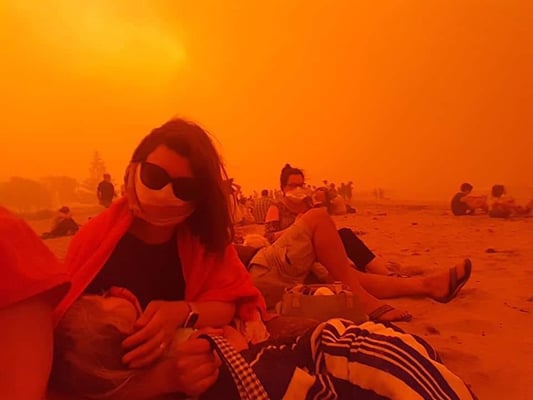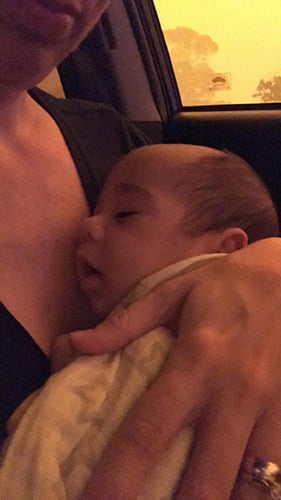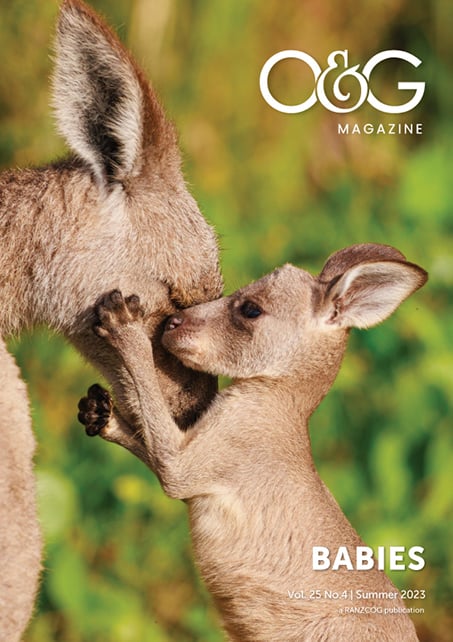It has been more than 3 years since my family and I faced the harrowing Black Summer Bushfires, and as another scorching, dry summer looms on the horizon, I’ve made it my mission to ensure that families receive better preparation and support in times of crisis.
I am a GP, an International Board Certified Lactation Consultant (IBCLC), a volunteer breastfeeding counsellor with the Australian Breastfeeding Association (ABA) and a mum of three young children. I live in Eurobodalla on the NSW South Coast and so experienced the Black Summer Bushfires first hand. The first time my family evacuated, on the final day of December 2019, it took us entirely by surprise. As the power went out and my husband set out for work at the hospital, I found myself seeking refuge with my children at our neighbour’s home, where we watched in dread as the bushfire steadily approached. Shortly after, my husband returned, his face drained of colour from witnessing the ferocity of the fires on his journey back from work. His words were blunt: ‘We have to evacuate immediately; it’s worse than you can imagine’.
I found the weeks and months during and following the bushfires exhausting. Over 500 homes were lost in my community. Countless families were evacuated, often multiple times. During this time, it became glaringly evident that infants and their mothers were among the most vulnerable in this ongoing disaster, and desperately needed more support.
As well as working as a GP, I am the Community Engagement Officer for the ‘Community Protection for Infants and Young Children in Bushfires Project’, an initiative of the ABA, launched in July 2022 with the support of the Australian Government. My co-author on this article, Dr Karleen Gribble, is the Project Lead and has worked for nearly 20 years to ensure protection and support for infants and young children and their mothers and other caregivers in disasters. We are eager to share our research insights as well as resources we have developed from our Project with those who care for pregnant women and new mothers across Australia.
What are disasters like for breastfeeding mothers?
In recent weeks, residents in many states across Australia have experienced the threat of bushfire. As we face the prospect of a hot arid summer, a combination of El Nino and climate change, memories of the 2019/20 bushfires are to the fore. During that disaster, infants and their mothers were vulnerable and in need of support.
Disruption of sanitation and water, electricity and food supplies are common in emergencies. When this occurs, breastfeeding safeguards infants, offering nourishment, hydration, protection from infections and comfort. However, emergencies can be challenging for breastfeeding mothers; they often worry about their milk supply and stop breastfeeding early. Obstetricians have a pivotal role in supporting and empowering mothers to continue breastfeeding amid adversity.
Consider Sarah’s experience. Her baby arrived via caesarean section in rural New South Wales and she was discharged on the third day after birth. When her baby was one week old, she had to evacuate due to a bushfire. Sarah, unable to drive, relied on her neighbour to reach the nearest evacuation centre, while her partner stayed behind to protect their property. Sarah spent a gruelling 24 hours sitting and sleeping on the floor of a basketball stadium with no privacy. She struggled to cope with the heat, smoke, post-operation pain and breast engorgement. She felt exposed breastfeeding in the crowded evacuation centre and feared for her partner. Her baby became increasingly unsettled, struggling to latch and feed effectively, leading Sarah to worry about her milk supply. Seeing her distress, someone gave her a tin of infant formula but on returning home, she was confronted with a power outage and a boil water notice. Sarah was in a quandary, believing her baby needed more milk but being concerned by the risks of formula feeding without the ability to boil water or access hot water for washing.
Experiences like Sarah’s are not uncommon during disasters. The Australian Breastfeeding Association’s Babies and Young Children in the Black Summer (BiBS) Study revealed the immense strain that the 2019/20 bushfires placed on families with babies and toddlers. Factors such as women evacuating alone with children and ill-equipped evacuation centres that were overcrowded with strangers and animals, with limited privacy and child care resources, all contributed to the challenges faced by breastfeeding mothers in the acute phase of the disaster.
Misconceptions about the impact of stress on breastfeeding were not uncommon among mothers and emergency responders supporting them. Mothers often interpreted infant fussiness and frequent feeding as signs of inadequate milk. Support for breastfeeding was not always available, leading some mothers to cease breastfeeding prematurely.
By offering support and guidance and dispelling myths, obstetricians can enable mothers to breastfeed their babies through emergencies.

Understanding the science of breastfeeding
Skin-to-skin and initiation of breastfeeding. Placed skin-to-skin with their mother immediately after birth, healthy newborns perform a series of behaviours culminating in them locating their mother’s nipple and suckling at the breast. More effective first breastfeeds occur in this skin-to-skin environment and the high levels of catecholamines in the infant promote learning. Thus, mothers whose infants experience their first breastfeed skin-to-skin have less problems with breastfeeding and their babies are less likely to be given infant formula in hospital or after discharge.
How milk is made
During pregnancy, the hormones progesterone, prolactin and oestrogen develop the alveoli (milk making structures) within the breasts. The removal of the placenta at birth causes a precipitous drop in progesterone, initiating copious secretion of milk. The hormone oxytocin is released from the mother’s brain when the infant suckles, causing myoepithelial cells that surround the alveoli to contract. This milk ejection reflex releases the milk to the baby, enabling them to feed. Over weeks, breastmilk production moves from hormone-driven (endocrine) production to a demand and supply (autocrine) way of working. This means that the more milk the baby removes by breastfeeding and the more frequently milk is removed, the more milk is made.
Milk production is unaffected by stress
Stress cannot disrupt the demand and supply milk-making process. Just as kidneys continue to function under stress, so too do mammary glands. However, babies pick up on the disrupted circumstances and the stress of their mother in emergencies. They often became more unsettled and want to feed more frequently, do not want to be separated from their mother, and wake more often overnight. While stress cannot reduce milk production, acute stress can slow the release of oxytocin, which can mean infants become fussy at the breast and can take longer to feed. Mothers often misinterpret these behaviour changes as indicating that there is a problem with their milk supply.
Dehydration and breastfeeding less can reduce milk supply
During emergencies, mothers’ water intake might be reduced because of lack of access to water, because they are too busy or stressed to remember to drink, or because they have restricted their intake due to a lack of toilets. Dehydration will decrease milk supply, but it rebounds if women rehydrate.
The chaotic nature of emergencies and lack of privacy might lead to mothers missing feeding cues or delaying breastfeeding, resulting in less frequent feeds and, in turn, reduced milk supply. More frequent feeding will enable milk supply to rebound.

How obstetricians can support mothers to protect their babies through breastfeeding in emergencies
Encourage women to consider emergencies in their infant feeding decisions and make an emergency preparedness plan.
Support women to breastfeed and to delay weaning until after the emergency season as a way of making them and their infants resilient to disasters.
Advise pregnant women and their partners to create an emergency plan that includes packing an evacuation kit for themselves and their infants. Encourage them to leave early and, if possible, seek shelter with relatives or friends rather than in evacuation centres. Refer mothers to the Australian Breastfeeding Association’s emergency preparedness resources (aba.asn.au/emergency), which include evacuation kit lists and fact sheets on breastfeeding or expressing milk in disasters.
Help mothers and babies get off to a good start with breastfeeding
Ensure that all mothers and infants experience skin-to-skin immediately after birth and until the baby breastfeeds (this takes a median of one hour). Avoid early supplementation with infant formula unless medically necessary.
Provide mothers with anticipatory guidance on normal infant behaviour in emergencies
Let them know to expect increased breastfeeds during emergencies. Emphasise the importance of keeping baby close and breastfeeding regularly. Let them know that if they feel their baby is fussy because their milk flow has slowed, a reliable way of getting the ‘love hormone’ oxytocin to speed up milk release is for them to look at their baby and think about how much they love them.
Empower mothers to recognise signs of adequate milk intake and to know how to increase their milk supply
Educate mothers on signs that their baby is receiving enough breastmilk, such as at least five heavily wet nappies in 24 hours (at 5 days of age or older), pale urine and soft stool consistency. Let them know that more frequent feeding will increase their milk supply and that if a woman is mixed feeding, it is possible to return to exclusive breastfeeding or even to relactate if she has stopped breastfeeding altogether.
Advise mothers to seek help
Assure mothers that if they encounter breastfeeding difficulties or have concerns about their milk supply, they can seek assistance from healthcare providers or the National Breastfeeding Helpline, available 24/7 on 1800 686 268.
Advocate for inclusion of pregnant woman and new mothers in your community emergency plans
This helps ensure that pregnant women and new mothers get the support they need during and after disasters. For more information on what the Black Summer Bushfires were like for pregnant women and new mothers, and what needs to be done to improve Australian emergency planning to better support them, read the BiBS Study Report.






Leave a Reply